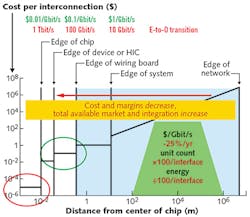Datacenters: OIDA report reveals disaggregated datacenter roadmap for photonics

On March 22, 2015, the fifth workshop in a series featuring optical networking and chaired by OSA Industry Development Associates (OIDA; Washington, DC), in collaboration with the Center for Integrated Access Networks (CIAN; Tucson, AZ) and sponsored by the U.S. National Science Foundation (NSF; Arlington, VA), was held in Los Angeles, CA, and summarized in the OIDA Report: Photonics for Disaggregated Data Centers.
The OIDA report's intention was to address the emerging topic of the disaggregation of datacenter networks with regard to photonic components. That is, silicon photonics and other optical components are thought to be capable of converting today's inflexible datacenter network into a more modular system, where motherboard, processor, network interconnects, and even software modules would be interchangeable and standardized such that multiple vendor options could be "plugged in" as separate devices acting independently and easily upgraded for truly scalable datacenter operation.
From the workshop presentations and discussions, several key findings, proposed disaggregated architectures, and gaps/opportunities in datacenter optics were presented and distilled into the OIDA report.
Key findings
The development of efficient silicon photonics and other hybrid or integrated semiconductor and optical architectures has long been the passion of big players like Intel (Santa Clara, CA) and IBM (Armonk, NY) and numerous photonic integrated circuit (PIC) transceiver manufacturers such as Infinera (Sunnyvale, CA) and Luxtera (Carlsbad, CA), and is now part of Facebook's trajectory with its Open Compute Project (OCP; www.opencompute.org). While details of a disaggregated datacenter differ among the players, all of them agree that fast optical interconnects enable a modular architecture.
Specifically, the report says that optics are best suited for disaggregated links between racks and possibly links with the racks, but are still not suited for the 1 m and less links inside the rack shelf where electronics dominate. The report goes so far as to define the link requirements—whether optical or electronic—in terms of the reach, bandwidth, latency, power consumption, physical footprint, and cost needed to make modular disaggregation possible (see figure).
Even though disaggregation replaces the traditional server with modular, pooled resources, the relocation of processors and memory beyond the rack (and even off the rack) is impractical. Essentially, CPU-to-CPU and CPU-to-memory traffic requires high-bandwidth, low-latency links and a better solution may be the disaggregation of some memory from the board.
And finally, the workshop found that only volume manufacturing processes could drive down the cost of optical interconnects to make disaggregated networking possible.
Proposed architectures, gaps, and opportunities
Among the modular architectures described, certain technology gaps remain as vendor opportunities: Facebook says that pluggable 100G transceivers will achieve a $100 price target, or $1/Gbit/s (for a 200–300 m single-mode duplex QSFP28 transceiver slated for 2016). But while this price/performance goal will expand the presence of optical interconnects, greater data rates are still needed and costs must be reduced for longer-reach links.
Intel's product architecture guru Donald Faw noted that today's proprietary and preconfigured architecture results in servers with utilization rates below 50%. Disaggregation, says Faw, makes a rack-scale architecture more modular and flexible, allowing innovations from multiple third-party vendors.
"Disaggregation is already happening to some extent, but the goal is to further disaggregate the server elements into pooled modules," says OSA senior industry advisor Tom Hausken. "The question is how far can it go, and where will optics have to be to play a role? It will be a challenge, to say the least, and disaggregation will be a solution only for some datacenter operators. But this is the new and interesting problem to solve."
REFERENCE
1. OIDA Report: Photonics for Disaggregated Data Centers, 1–29 (June 2015).
About the Author

Gail Overton
Senior Editor (2004-2020)
Gail has more than 30 years of engineering, marketing, product management, and editorial experience in the photonics and optical communications industry. Before joining the staff at Laser Focus World in 2004, she held many product management and product marketing roles in the fiber-optics industry, most notably at Hughes (El Segundo, CA), GTE Labs (Waltham, MA), Corning (Corning, NY), Photon Kinetics (Beaverton, OR), and Newport Corporation (Irvine, CA). During her marketing career, Gail published articles in WDM Solutions and Sensors magazine and traveled internationally to conduct product and sales training. Gail received her BS degree in physics, with an emphasis in optics, from San Diego State University in San Diego, CA in May 1986.